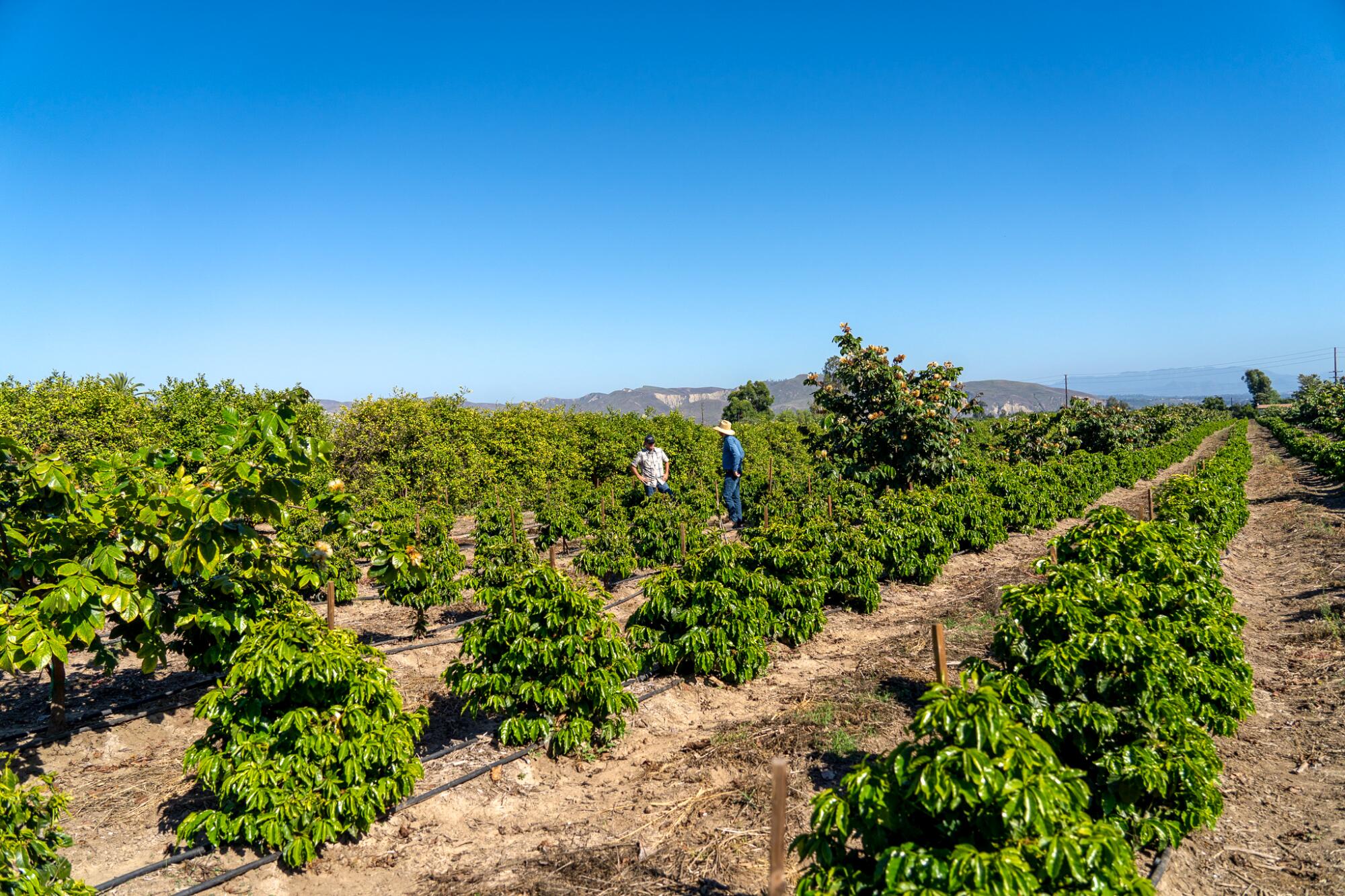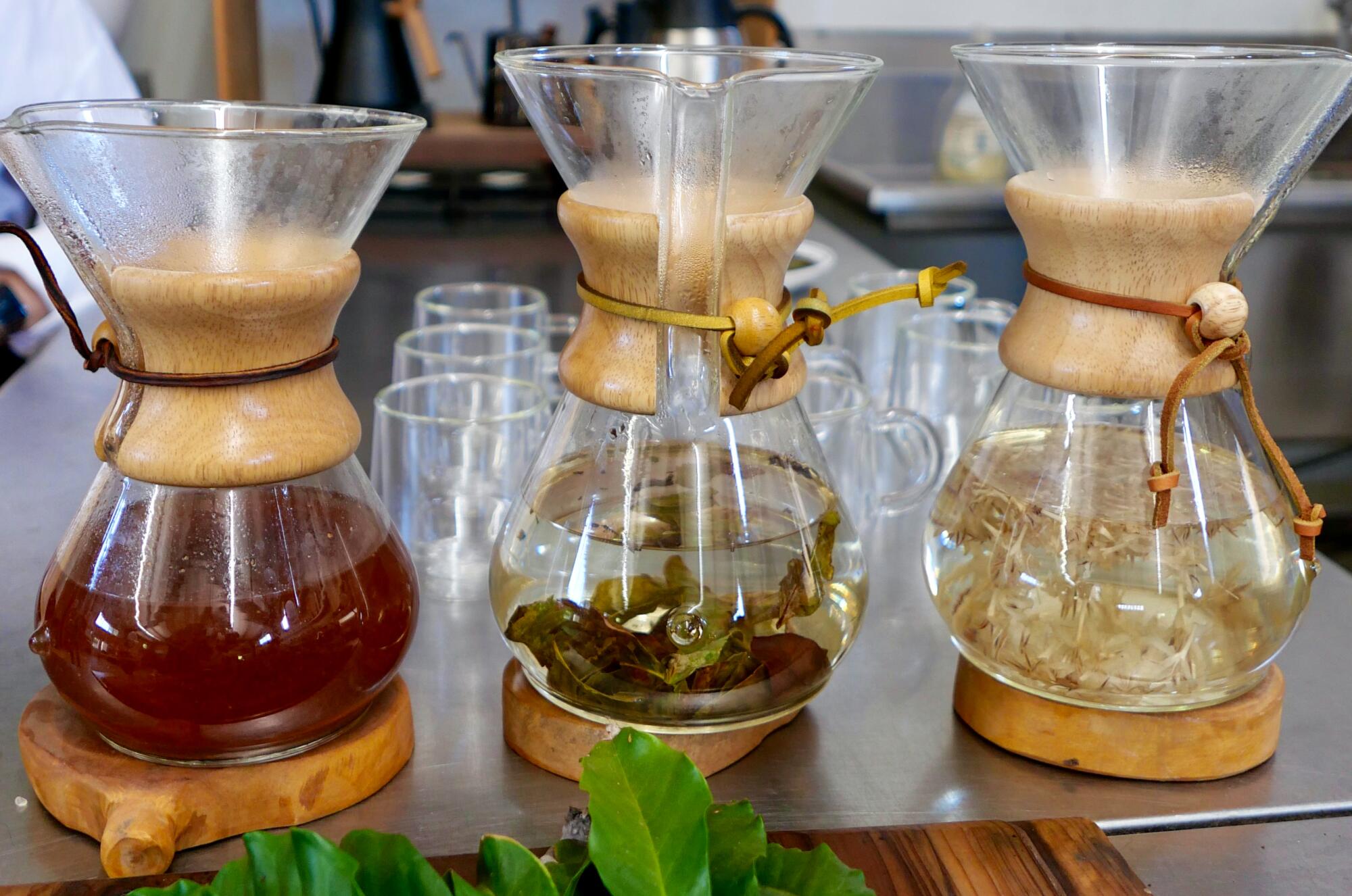It’s a Sunday afternoon at the San Francisco Coffee Festival in Fort Mason, and Jay Ruskey, founder of Frinj Coffee, stands at his booth in front of a row of lush green plants wrapped in burlap. He takes a Chemex and pours some aromatic, freshly brewed coffee into miniature cups. Ruskey and Frinj’s head roaster, Richard Masino, look up to see a long line of customers snaking past several other booths.
Everyone is waiting to try coffee made from beans grown in California—yes, California—not Ethiopia, Colombia, or Peru, but Frinj coffee grown in Goleta, north of Santa Barbara. The coffee in the Chemex comes from Ruskey’s trees, planted on his Good Land Organics farm, which also serves as headquarters in Frinj.
Frinj is on a mission to ensure that coffee crops, previously grown only in tropical climates, can thrive in the Golden State. Before 2000, little or no coffee was grown in California. Today, 14 varieties of coffee are carefully nurtured on more than 65 farms in Southern California from Santa Barbara to northern San Diego.
The results of this work are gaining recognition and fans in the coffee world. In May and throughout the summer, more California coffee will be harvested than ever before.
It’s a drop in the ocean compared to the several million pounds grown annually in Brazil alone, but the quality of California coffee is attracting international attention. Recently, Blue Bottle founder James Freeman showcased the California-grown Gesha Frinja variety at a coffee tasting in Los Angeles. Goodland Organics Gesha pour-over coffee – with fresh and fruity notes of peach, jasmine and strawberry – was served alongside two exceptional coffees, Panama Finca Deborah Interstellar Gesha and Yemen Hayma Kharijiya Aljidan XI.
“It’s an honor to have coffee grown so close to where I live that’s as good as any farm I’d have to travel across the globe to get to,” Freeman says.
Tokyo baristas Hide Izaki and Miki Suzuki visited Good Land Organics to sample Frinj coffee. Izaki and Suzuki travel the world to find uncommon, top-quality examples to serve at their coffee tastings, Cokuun. Both said they were impressed as they excitedly sipped from their tasting cups.
California coffee is gaining international fans. Hide Izaki, left, founder of Tokyo coffee tasting Cokuun, checks out Good Land Organics in Goleta with farmer Jay Ruskey.
(Julie Wolfson)
It took Ruskey several tries after first planting coffee trees in 2002 to learn the best practices for growing coffee in Southern California. While the tropical climate averages above 60 degrees year-round and has generally high rainfall, he and other California coffee growers focus on working with weather patterns, multi-cropping with other crops and using water carefully.
“I’ve always had a passion for adapting crops,” Ruskey says. “I was working with the UC Cooperative Extension Service to plant lychee and longan when Dr. Mark Gaskell, an expert in small-scale berry crops, gave me 40 coffee plants and encouraged me to try planting them with other crops.”
Good Land Organics occupies 42 acres of hillside property on the western edge of Goleta, near the University of California, Santa Barbara, with 10 acres of lush vegetation and more than 3,500 coffee plants along avocado trees that provide shade and shelter. The farm also grows iceberg beans, persimmons, pomegranates, passion fruit, dragon fruit, cherimoya and caviar in soil made more fertile by the biodiversity of the crops.
Ruskey sold his first crop of roasted beans at the Santa Barbara Farmers Market and through the Good Land Organics website.
When the Daily Coffee News blind-tasted Ruskey’s coffee in 2014 and ranked it 27th in the world, it gave him the confidence to treat his project as more than just an experimental crop. He eventually began offering Frinj roasted beans in some of his coffee shops, including Bird Rock in San Diego, Burnside in Sacramento and Make Worth Coffee in Bellingham, Washington. The Steward Hotel in Santa Barbara serves Frinj as part of its efforts to highlight local ingredients.
In Los Angeles, Goodboybob added Frinj coffee to its pour-over menu and included it in its uncommon coffee subscription. Marcus Newborn, executive vice president of coffee, has consulted with Frinj and as the farm’s yields escalate, he intends to offer more in the future.

Once established, the trees can produce coffee every year for more than 25 years. “We’re still in the early stages of the California coffee industry,” says Jay Ruskey of Frinj Coffee.
(Jonnah Perkins)
“We’re always excited to have this dish on our menu,” Newborn says. “Jay’s been a part of our speaker series, and we love when he brings in coffee trees, tying the conversation into something local.”
Frinj also explores the uses of other parts of the coffee plant. Coffee leaves, flowers, and cherries (fruit) are featured in a tea-style course at Blue Bottle Studio, brewed as elegant infusions.
“We’ve really stuck with this bean,” Ruskey says. “Being an orchardist at heart, processing this attractive fruit with these elaborate flavors, antioxidants, and all these well products in fruit that would normally be composted, I think it’s just wasteful and tragic. So I think there are opportunities.”
When Ristenpart went camping with his students at Good Land Organics to get hands-on experience, they tried fresh cascara syrup (dried coffee cherries). “We made pancakes with blueberries in the morning and poured them over like maple syrup,” he says. “Best pancakes I’ve ever had!”

Coffee flower tea? Jay Ruskey uses various parts of the coffee plant, including leaves and flowers, to brew infusions.
(Julie Wolfson)
Frinj also provides plant material, cultivation support and sales opportunities to other coffee growers.
“Seven years ago, none of this infrastructure was in place,” Ruskey says. “Coffee is essentially a tree fruit crop, which means it can be a long process to grow because it can take four to five years to get your first crop.”
Once coffee bushes take root, the trees can produce coffee annually for more than 25 years, “so we’re still very early in the development of the California coffee industry,” he adds
Frinj processes post-harvest coffee, sells green beans, roasts beans and provides sales channels in its own online store and directly to coffee producing companies.
Currently on my own websiteroasted coffee of various varieties from several farms costs from $15 to $125. The Sundays at Toro coffee, grown in Santa Barbara County by Chris and Kristina McCausland, is a Pacas variety with flavor notes of black cherry, passion fruit, cocoa and port wine.
Frinj coffees made an appearance at the 2023 US Brewers Cup, a prestigious competition that highlights the art of filter coffee brewing, in Portland, Ore. Elika Liftee, director of barista education at Onyx Coffee in Arkansas, competed in the finals with a blend grown at Rancho Delfino in Carpinteria.
“Ideally, we would like to be seen as a premium coffee,” Ruskey says, “and be served in coffee shops where customers want to try some of the best coffee in the world.”

Thanks for sharing. I read many of your blog posts, cool, your blog is very good.
Thank you so much for your kind words and for being a dedicated reader of our blog! We’re thrilled to hear that you’re enjoying our posts. Don’t forget to subscribe to our newsletter for the latest updates and exclusive content.